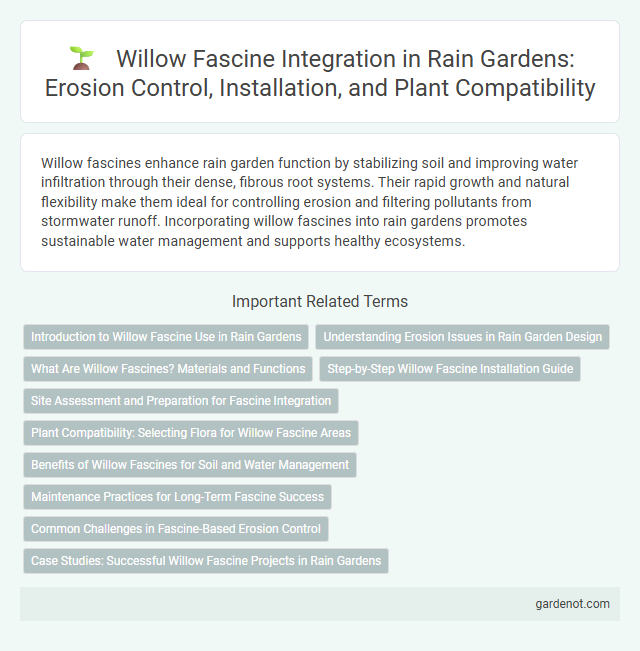Willow fascines enhance rain garden function by stabilizing soil and improving water infiltration through their dense, fibrous root systems. Their rapid growth and natural flexibility make them ideal for controlling erosion and filtering pollutants from stormwater runoff. Incorporating willow fascines into rain gardens promotes sustainable water management and supports healthy ecosystems.
Introduction to Willow Fascine Use in Rain Gardens
Willow fascine, composed of bundles of live willow branches, serves as an effective natural erosion control method in rain gardens by stabilizing soil and enhancing water absorption. These fascines root quickly once installed, creating a dense, living barrier that filters runoff and supports native plant growth. Their use in rain gardens promotes improved stormwater management and habitat creation through sustainable landscape engineering.
Understanding Erosion Issues in Rain Garden Design
Willow fascines play a crucial role in controlling soil erosion within rain garden design by stabilizing slopes and promoting water infiltration. Their dense root systems bind the soil, reducing surface runoff and preventing sediment displacement. Incorporating willow fascines helps maintain the structural integrity of rain gardens, enhancing their effectiveness in managing stormwater.
What Are Willow Fascines? Materials and Functions
Willow fascines are bundles of live willow branches used in erosion control and water management within rain gardens. These flexible, water-tolerant materials promote soil stabilization by rooting quickly along stream banks or damp areas, reducing runoff and sediment loss. Their natural ability to grow rapidly and adapt to wet environments makes willow fascines an eco-friendly solution for enhancing rain garden durability and habitat quality.
Step-by-Step Willow Fascine Installation Guide
Willow fascine installation begins with selecting fresh, flexible willow branches, typically harvested during late winter or early spring to ensure optimal rooting. Prepare the site by digging a shallow trench along the rain garden contour, then bundle and tightly bind the willow cuttings before laying them horizontally in the trench, overlapping ends to maintain stability. Backfill with native soil, tamp it gently, and water thoroughly to promote rooting and secure the fascine, which enhances erosion control and moisture retention in the rain garden system.
Site Assessment and Preparation for Fascine Integration
Willow fascine integration begins with thorough site assessment, including soil type, moisture levels, and slope gradient to ensure optimal growth conditions and effective erosion control. Preparing the site involves clearing invasive vegetation, loosening compacted soil, and moisture conditioning to support willow cutting establishment. Proper planning with detailed evaluation of hydrology and sediment deposition patterns enhances the long-term stability and functionality of the willow fascine within the rain garden.
Plant Compatibility: Selecting Flora for Willow Fascine Areas
Willow fascines thrive best when paired with moisture-tolerant plants such as sedges, rushes, and native wetland grasses, which enhance soil stabilization and water retention in rain garden environments. These companion plants support the structural integrity of willow fascines by preventing erosion and promoting biodiverse habitats. Selecting native species adapted to local hydrological conditions ensures optimal growth and ecological balance in willow fascine rain gardens.
Benefits of Willow Fascines for Soil and Water Management
Willow fascines improve soil stability by anchoring riverbanks and reducing erosion through their dense root systems. Their natural ability to absorb and filter stormwater enhances water quality and supports groundwater recharge. These bioengineering structures also promote biodiversity by creating habitats along waterways.
Maintenance Practices for Long-Term Fascine Success
Willow fascine maintenance involves regular monitoring for structural integrity, ensuring proper water flow, and timely replacement of dead or damaged willow stakes to promote healthy root development. Periodic pruning prevents overgrowth, enhances aeration, and supports rapid soil stabilization within the rain garden. Maintaining optimal moisture levels and controlling competing vegetation are critical for long-term fascine success and effective stormwater management.
Common Challenges in Fascine-Based Erosion Control
Willow fascines often face challenges such as inadequate root establishment, which reduces their effectiveness in stabilizing soil along stream banks. Erosion control can be compromised by improper installation techniques that fail to secure the fascines firmly, leading to displacement during high flow events. Furthermore, pest infestations and seasonal dieback can limit their long-term viability in rain garden ecosystems.
Case Studies: Successful Willow Fascine Projects in Rain Gardens
Willow fascine installations in rain gardens have shown remarkable success in controlling erosion and enhancing water absorption in urban landscapes. Notable case studies, such as the Baltimore Inner Harbor restoration, demonstrate how dense willow bundles stabilize soil while promoting native biodiversity. These projects highlight the effectiveness of willow fascines in sustainable stormwater management and habitat creation in urban rain garden environments.
Willow fascine Infographic

 gardenot.com
gardenot.com